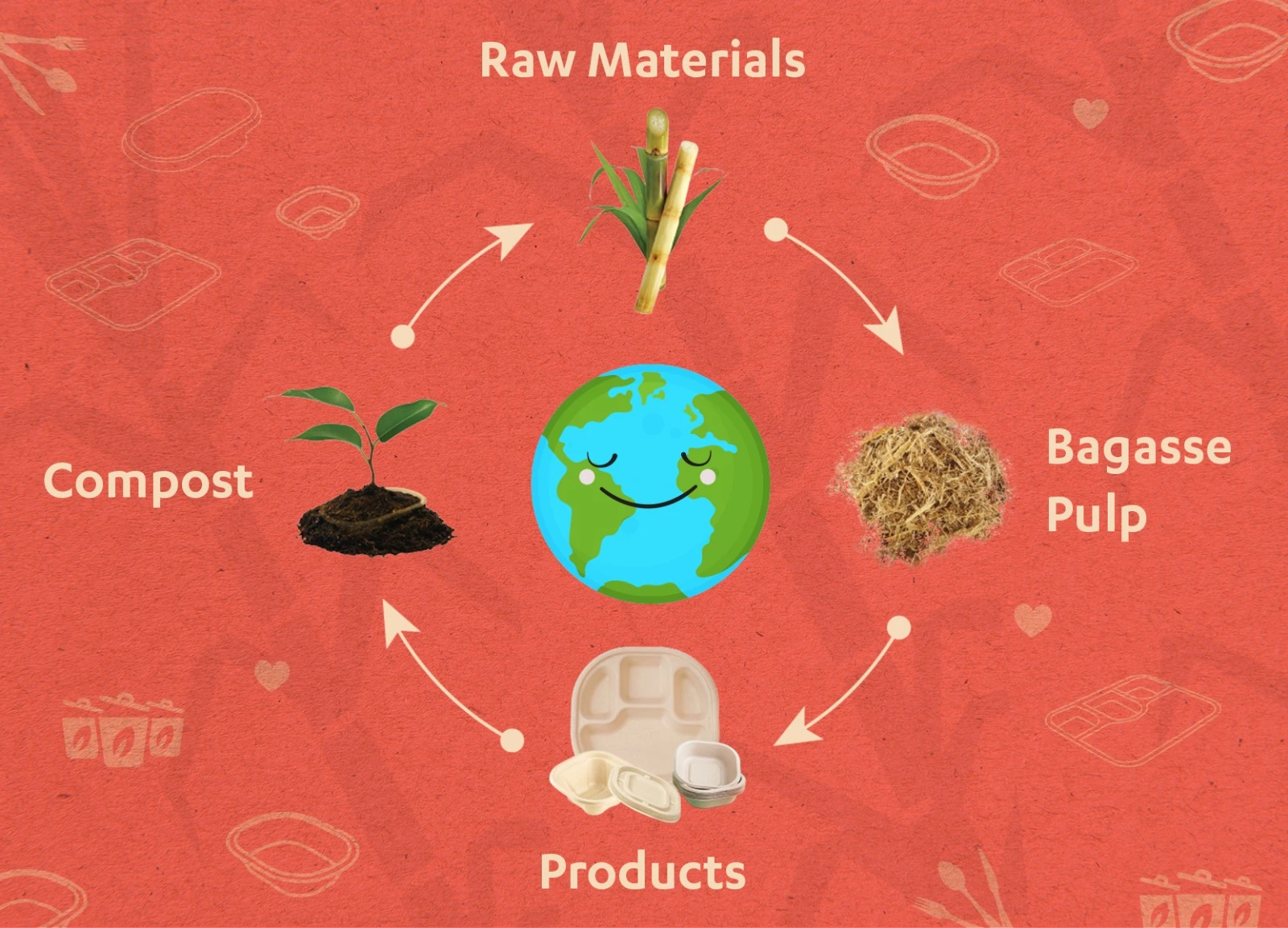From Sugarcane to Smiling Faces: The Journey of Bagasse Plates!
Introduction
In our relentless pursuit of a more sustainable future, let’s bid farewell to the boring and embrace the extraordinary! Say “ta-ta” to polyethylene and wave hello to the fabulous world of compostable bagasse plates. In this captivating blog post, we’ll unravel the secrets of its manufacturing process, discover the environmental benefits of using these sustainable products, explore its sustainable qualities, and even unveil the magical art of composting these wonders right in your own backyard. Get ready to embark on a whimsical journey from sugarcane to smiling faces!
What is Bagasse?
Bagasse refers to the fibrous residue that remains after sugarcane stalks are crushed to extract their juice. Traditionally, bagasse was considered waste and often burned, resulting in air pollution. However, innovative thinkers from the manufacturing industry found a way to transform this byproduct into something useful and sustainable – compostable tableware.
Understanding Compostable vs. Biodegradable: What’s Better?
In the world of sustainable products, there’s a battle brewing between “biodegradable” and “compostable” disposables. Both boast green cred, but hold onto your reusable tote bags, there’s a twist!
Think of biodegradable like a stubborn sloth: yeah, it eventually breaks down, but after years of lounging in landfills, looking suspiciously plastic-y. Compostable, on the other hand, is the Usain Bolt of eco-warriors. These sugarcane plates transform into nutrient-rich soil in a flash, thanks to hungry microbes chomping at the bits.
Imagine a bagasse plate making machine crafting out these compostable champions, while disposable plate factories crank out their sluggish biodegradable cousins. One whispers sweet nothings to the Earth, the other leaves a landfill hiccup. The choice is clear!
By choosing compostable tableware over biodegradable plates, you are making a conscious choice to reduce environmental impact and contribute to a cleaner future.
The Manufacturing Process: Transforming Sugarcane into Sustainable Products
Collect Bagasse:
Instead of burning leftover sugarcane stalks (bad for air!), we turn them into awesome compostable plates with cool machines! These ‘sugarcane plates‘ are kind to the planet, unlike their plastic pals, yet tough enough to boost paper strength. So, let’s switch to compostable sugarcane plates and reap the environmental benefits of choosing better sustainable products.
Clean and Dry:
Now, let’s give that bagasse a good scrub-a-dub-dub to eliminate any unwanted guests and keep things squeaky clean. Once all spick and span, we need to let it air dry like a pro, getting rid of any lingering moisture and getting it ready for the next exciting step. At this point, we separate the fibrous and non-fibrous parts (pith and lignin) using a depither. This machine ensures that we’re left with pure bagasse goodness, free from any impurities, as we move on to the pulping stage.
Pulping:
Once the dried bagasse is feeling all light and airy, we give shred and send it off to the pulping machine for some serious fun! We break down those fibers and create a delightful pulp concoction that’s perfectly blended and ready for the next adventure. Let the pulping party begin!
Molding:
Time to pour that pulped goodness into a bagasse plate making machine, making sure every nook and cranny gets its fair share. And here comes the fun part – a little pressure, a little squeeze – we remove any excess water and shape that mixture into the most fabulous plate form you’ve ever laid eyes on. It’s like art, but with pulp! Voila, our disposable plate making machine is giving shape to a masterpiece because that is what you deserve in your restaurant!
Pressing and Drying:
Now it’s time to give those sugarcane plates a good ol’ hydraulic hug in our press, squeezing out any remaining water and compacting the pulp into perfection. Once they’ve had their squeeze, we whisk them away to a special drying zone with just the right temperature and humidity – it’s like a spa day for plates! We give them all the time they need to dry and solidify, making sure they’re as stable and durable as can be.
Trimming and Finishing:
Once our sugarcane plates have had a chance to soak up all that drying goodness, we gently pluck them out of their molds. We take a little off the edges, smooth things out, and give them a touch of finesse for a refined and visually stunning finish.
Quality Check:
It’s time for some serious plate scrutiny! At first, there’s a stringent quality check where we assess the resistance of our sustainable products to water and oil at 100°C for 30 minutes. We go above and beyond by conducting not one, not two, but seven comprehensive checks in our quality process. This rigorous approach ensures that every single plate that leaves our facility is of the utmost quality. No room for flaws or imperfections here!
Packaging:
Now that our plates are looking mighty fine, it’s time to get them all dressed up for their journey. We carefully pack them in materials that will keep them safe and sound during transportation and storage. But here’s the best part – even our packaging is compostable! We use PLA (polylactic acid) for packaging, ensuring that every element of our product is sustainable and eco-friendly. Because a good package is just as important as what’s inside!
There you go! Now enjoy the satisfaction of contributing to a more environmentally conscious approach to plate production.
Environmental Benefits: Making a Positive Impact on the Planet
By choosing bagasse compostable tableware, you are actively contributing to a cleaner planet. Let’s explore some of the key environmental benefits:
Reduced reliance on bio degradable and non bio-degradable resources:
Bagasse tableware is made from a renewable resource – sugarcane. By opting for bagasse-based products, we can significantly reduce our dependence on materials derived from fossil fuels.
Lower carbon footprint:
Compared to traditional tableware made from polyethylene or foam, bagasse tableware has a significantly lower carbon footprint. It helps reduce greenhouse gas emissions and combat climate change.Biodegradability: Bagasse tableware is fully compostable. When disposed of in a composting facility, it breaks down naturally, returning valuable nutrients to the soil.
Turn Trash to Treasure: Composting Sugarcane Plates in Restaurants
Remember those awesome sugarcane plates that saved you from plastic guilt? Don’t let them meet the same fate as their non-biodegradable cousins in the landfill! Give them a superhero second act with restaurant composting, transforming waste into earthy gold for local farms or community gardens. Here’s your step-by-step guide to becoming a restaurateur with superpowers:
Step 1: Assemble the Green Team:
- Designate a hero bin: Dedicate a separate bin just for used sugarcane plates. Label it clearly to encourage staff and customers to segregate correctly.
- Spread the word: Train your staff on the composting process and its environmental benefits. Share the “why” behind this initiative to boost team morale and customer engagement.
Step 2: Prep the Plates for Transformation:
- Shredding is best: Smaller pieces decompose faster. Invest in a commercial shredder or encourage customers to tear larger plates into smaller bits on their way out.
- No shredder, no problem: No worries if a shredder isn’t feasible. Simply tear or cut the plates into manageable pieces to speed up composting.
Step 3: Partner Up for Composting Magic:
- Connect with composting facilities: Research local composting facilities that accept commercial food waste. You might partner with farms, community gardens, or dedicated composting companies.
- Consider in-house composting: If space and resources allow, explore setting up your own dedicated compost bin or tumbler for sugarcane plates. This option gives you more control over the process and lets you showcase your sustainability efforts directly to customers.
Step 4: Keep the Green Gang Thriving:
- Maintain proper moisture: Regularly mist the compost pile to keep it moist but not soggy. Think of a damp towel, not a wet sponge.
- Aerate for happy microbes: Turn the compost pile regularly using a shovel or pitchfork. This ensures proper airflow, allowing good bacteria to thrive and break down the plates efficiently.
Step 5: Share the Success Story:
- Celebrate the transformation: Once the compost is ready, use it to nourish local farms or community gardens. Share the journey with your customers, showcasing the full circle of sustainability from plate to plant.
- Inspire others: Educate your customers about the composting process and the positive impact it has on the environment. Encourage them to compost at home, spreading the green revolution beyond your restaurant walls.
Remember, composting sugarcane plates is not just about waste reduction; it’s about building a thriving ecosystem, enriching local communities, and inspiring others to be responsible environmental stewards. So, ditch the landfill blues, embrace the green revolution, and watch your restaurant become a champion for a healthier, cleaner planet, one plate at a time!
Conclusion: Embrace Sustainability and Make a Difference Today!
Choosing bagasse compostable tableware is a small but meaningful step towards a more sustainable future. By opting for this eco-friendly alternative, you can make a positive impact on the environment while enjoying the convenience and functionality of high-quality tableware.
Explore the range of available bagasse compostable disposables and learn more about the sustainable options here. You’ll find comprehensive information about our products and their sustainability features.
Together, let’s embrace sustainable solutions laced with environmental benefits and work towards a cleaner planet! So, make the switch to bagasse tableware today and experience nature’s magic as it transforms waste into rich, nutrient-dense compost.
Frequently Asked Questions about Bagasse Tableware
You may have a few questions about compostable bagasse tableware and its environmental benefits. Here are the answers to some of the most frequently asked questions.
Is bagasse tableware safe to use?
Absolutely! Bagasse tableware is made from the sugarcane byproduct and is free from harmful chemicals. It’s safe for both hot and cold foods and is microwave safe.
How does bagasse tableware help the environment?
Since it’s made from a renewable resource and is compostable, bagasse tableware reduces the amount of waste going into landfills. It takes less energy to produce, reducing carbon emissions.
Is bagasse tableware more expensive than regular tableware?
While the initial costs may be slightly higher, the long-term environmental benefits make bagasse tableware an economically sound choice. Remember, when you choose bagasse, you’re investing in our planet’s future.
Where can I purchase bagasse tableware?
Bagasse disposables are available at various online and physical stores. You can explore the range of available bagasse compostable tableware products here and connect with our partners.
Feel free to reach out to us if you have more questions! Let’s work together to make our planet cleaner and healthier.


